| Exhibition Dates: | October 16, 2018–October 4, 2020 |
| Exhibition Location: | The Met Fifth Avenue, Lower Level, Robert Lehman Wing, Galleries 964–965 |
“The Met’s rich holdings of 17th century Dutch masterpieces—the most extensive collection outside of Europe—have always been immensely popular with our visitors,” said Max Hollein, Director of The Met. “This exhibition is a chance to gain a deeper understanding of how the shifting cultural climate of the time spurred artistic innovation and gave rise to some of the most beloved works of western art in all of history.”
The presentation will offer a fresh perspective on the canon and parameters of the Dutch Golden Age by uniting paintings from Benjamin Altman's bequest, the Robert Lehman Collection, and the Jack and Belle Linsky Collection. It also provides an opportunity to display recently conserved works, including Margareta Haverman's A Vase of Flowers and Rembrandt's late self-portrait, as well as works that are rarely on view.
The title of the exhibition comes from one of the period’s major works of art theory, Philips Angel’s The Praise of Painting (1642), a pioneering tribute to painting’s ability to imitate nature and achieve realistic effects.
As The Met approaches the 150th anniversary of its founding in 2020, this exhibition provides an apt opportunity to celebrate a core aspect of the Museum’s storied collection.
Exhibition Overview
The exhibition will open with one of The Met’s most prized works of art:
Rembrandt (Rembrandt van Rijn) ( Dutch, Leiden 1606 – 1669 Amsterdam ). Aristotle with a Bust of Homer , 1653 . Oil on canvas , 56 1/2 x 53 3/4 in. (143.5 x 136.5 cm) . The Metropolitan Museum of Art, New York, Purchase, special contributions and funds given or bequeathed by friends of the Museum, 1961 ( 61.198 )
Aristotle with a Bust of Homer (1653), by Rembrandt van Rijn, the painter who has dominated public perception of the Dutch Golden Age. In this meditation on the transience of fame, Rembrandt contrasts worldly renown with enduring artistic achievement at a time when his own somber and expressive style was beginning to fall out of fashion.
The exhibition will then unfold in nine thematically organized galleries. The first themed gallery, Faces of a New Nation, will examine how portraiture was used to express identity and status at a moment when Dutch society was experiencing unprecedented social mobility and diversity. Among the portraits will be four paintings by Rembrandt—including his 1640 depiction of Herman Doomer, a successful cabinetmaker—and Frans Hals’ swaggering 1643 portrait of Paulus Verschuur, a wealthy merchant from Rotterdam.
The next two galleries will familiarize visitors with the Dutch Republic’s religious and geographical landscapes.
Questions of Faith will juxtapose views of the reformed interiors of Protestant churches

(Emanuel de Witte’s Interior of the Oude Kerk, Delft, from ca. 1616–1692)
with images of Catholic devotion

(Vermeer’s Allegory of the Catholic Faith, from ca. 1670–72) to reflect the religious diversity of the Dutch Republic.
Staking a Claim will look at the flat terrain of the Netherlands—the unlikely inspiration for the birth of landscape painting as an independent genre in Europe. Some Dutch painters embraced the open vistas and dramatic skies of their home turf,
Jacob van Ruisdael (Dutch, Haarlem 1628/29–1682 Amsterdam)
Wheat Fields, ca. 1670
Oil on canvas, 39 3/8 x 51 1/4 in. (100 x 130.2 cm)
The Metropolitan Museum of Art, New York, Bequest of Benjamin Altman, 1913 (14.40.623)
as seen in Jacob van Ruisdael’s monumental Wheat Fields (ca. 1670).
Other artists drew on their travels or imaginations, exemplified by

Frans Post’s mixture of fantasy and observation in A Brazilian Landscape (1650)
and Albert Cuyp’s idyllic scene in Young Herdsmen with Cows (ca. 1655–60).
Rembrandt’s impact on the canon of Dutch paintings will be the focus of Masters, Pupils, Rivals. The extraordinary quality of Rembrandt’s late self-portrait will be even more evident following the recent removal of a synthetic varnish dating to the mid-20th century. The work is contrasted with a self-portrait from about 1665 by the artist’s first student, the influential Dutch artist Gerrit Dou.

Rembrandt’s Portrait of Gerard de Lairesse (1665–1667), from the Lehman Collection,
Gerard de Lairesse ( Dutch, Liège 1641 – 1711 Amsterdam ). Apollo and Aurora , 1671 . Oil on canvas 80 1/2 x 76 1/8 in. (204.5 x 193.4 cm) . The Metropolitan Museum of Art, New York, Gift of Manuel E. and Ellen G. Rionda, 1943 ( 43.118 )
and Lairesse’s own Apollo and Aurora (1671), long in the Museum’s storage, will be presented side by side, producing a visually compelling narrative about the tensions between realism and idealism during this period.
Particularly in the first half of the 17th century, Dutch collectors reveled in scenes of merriment and misbehavior among the lower classes.
The Comic Painting gallery will display a selection of these down-to-earth and sometimes crude scenes. Examples will include the amusing carnival atmosphere in
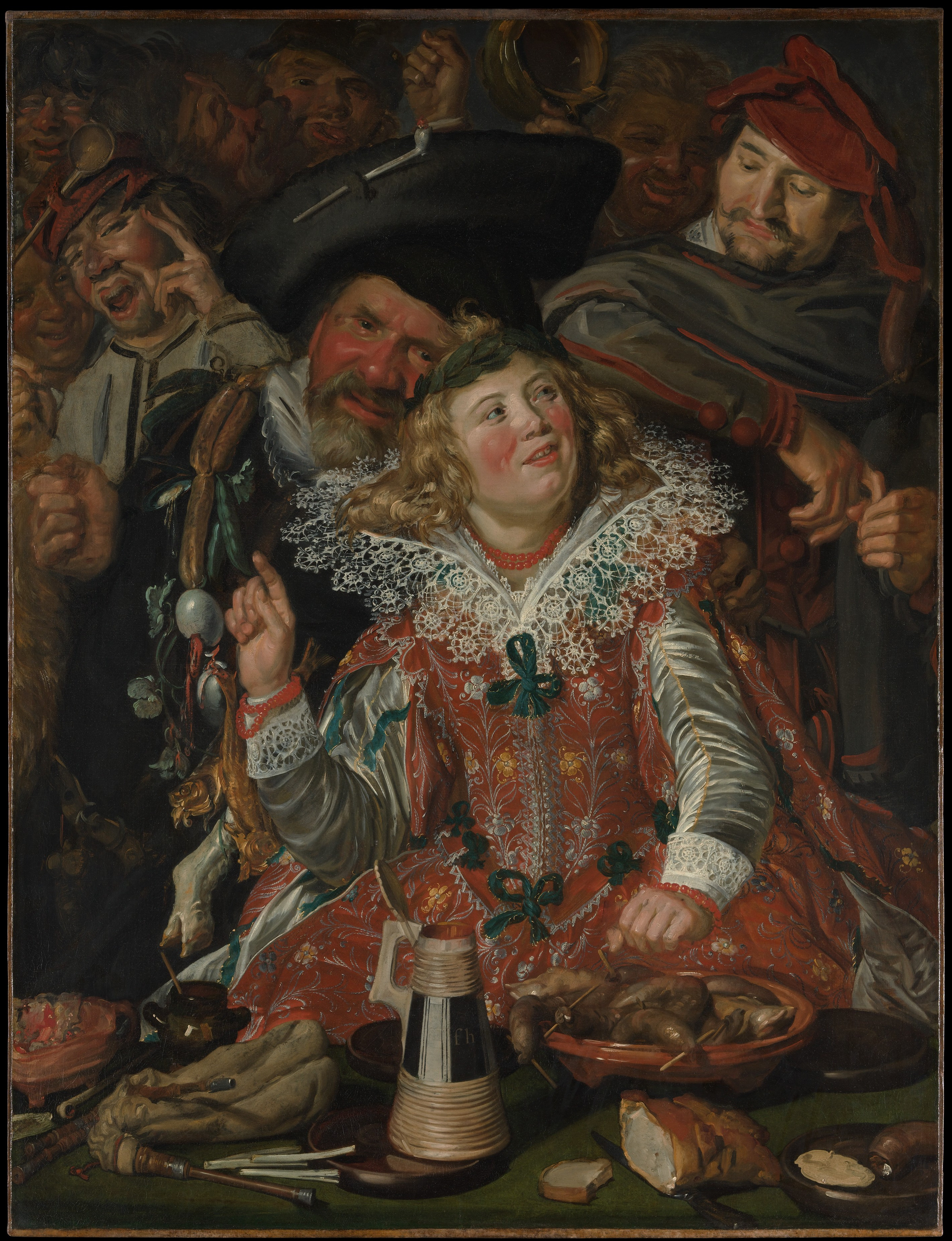
Frans Hals’ Merrymakers at Shrovetide (ca. 1616–17), depicting the holiday now better known as Mardi Gras,
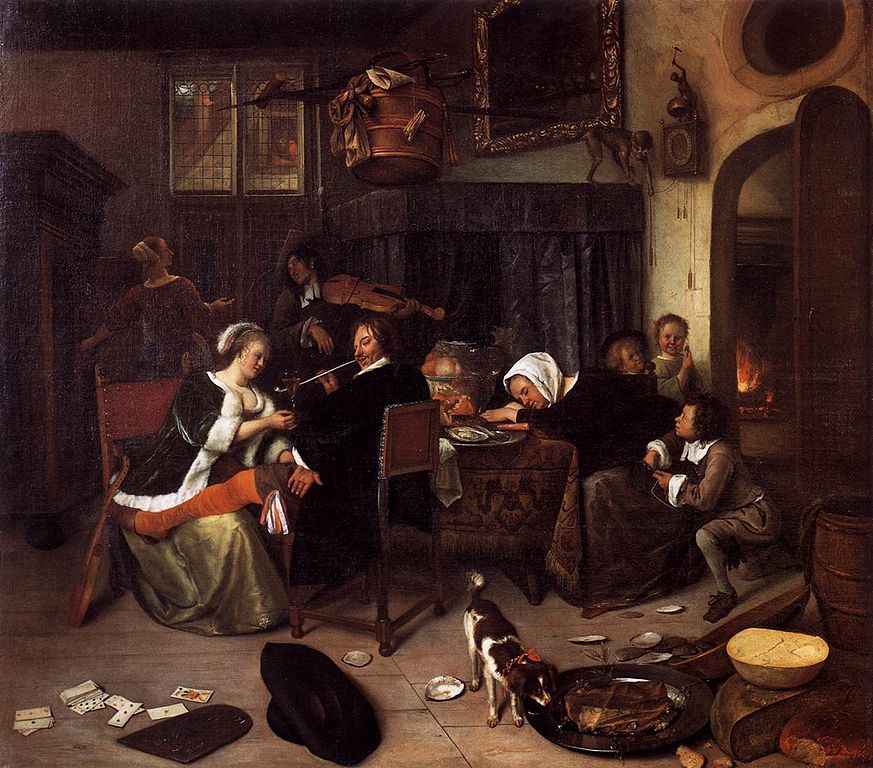
Jan Steen (Dutch, Leiden 1626–1679 Leiden)
The Dissolute Household, ca. 1663–64
Oil on canvas, 42 1/2 x 35 1/2 in. (108 x 90.2 cm)
The Metropolitan Museum of Art, New York, The Jack and Belle Linsky Collection, 1982 (1982.60.31)
and the domestic chaos in Jan Steen’s The Dissolute Household (ca. 1663–64).
Contested Bodies will showcase the diverse approaches that Dutch painters took in representing the human form. For example, Rembrandt’s realistic female figures in
Bellona (1633)

and The Toilet of Bathsheba (1643)
will be contrasted with the contorted, supernaturally muscular bodies in
Abraham Bloemart’s Moses Striking the Rock (1596).
The exhibition then transitions from the human figure to commentary on human vanity and the pleasures of consumption as captured in still life painting, which, like landscape, was a new and experimental genre in the Dutch Golden Age.
The Eloquent Things gallery will feature Margareta Haverman’s newly conserved Vase of Flowers (1716)—one of only two known paintings by the artist and the only painting by an early modern Dutch woman in the Museum’s collection.
Pieter Claesz’s exceptional powers of observation will be on full display in Still Life with a Skull and a Writing Quill (1628), a richly symbolic work about the brevity of life.
In Lives of Women, visitors will encounter one of the major themes of 17th-century Dutch art: the everyday activities of women observed while keeping house, getting dressed, or caring for children. Paintings in this section will include
Rembrandt’s Hendrickje Stoffels (mid 1650s),
Gerard ter Borch’s A Young Woman at Her Toilet with a Maid (ca. 1650–51),
and Vermeer’s A Maid Asleep (ca. 1656–57). These interior scenes will carry over into the final gallery,
Behind Closed Doors, which will afford a peek into 17th-century amorous pursuits and civilized leisure as depicted in “high-life genre paintings.” Gerard ter Borch and Pieter de Hooch pioneered this style, which reached its apogee in the work of Vermeer. Highlight works will include Vermeer’s Young Woman with a Water Pitcher (ca. 1662), the first work by the artist to enter an American museum’s collection; Ter Borch’s Curiosity (ca. 1660–62), showing three women in a luxuriously appointed interior; and De Hooch’s Leisure Time in an Elegant Setting (ca. 1663–65).
In Praise of Painting: Dutch Masterpieces at The Met is organized by Adam Eaker, Assistant Curator in The Met’s Department of European Paintings.

-
Rembrandt (Rembrandt van Rijn) (Dutch, Leiden 1606–1669 Amsterdam)
Portrait of Gerard de Lairesse, 1665–67
Oil on canvas, 44 3/8 x 34 1/2 in. (112.7 x 87.6 cm)
The Metropolitan Museum of Art, New York, Robert Lehman Collection, 1975 (1975.1.140)
-
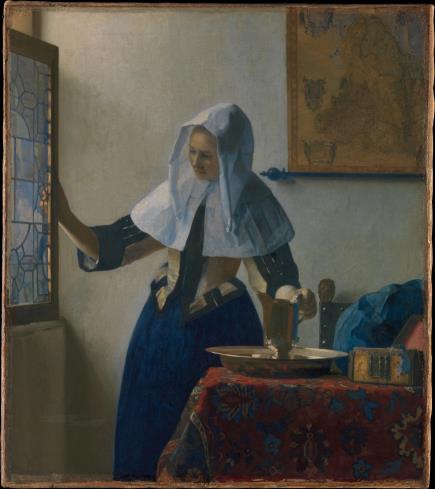
- Johannes Vermeer (Dutch, Delft 1632–1675 Delft)
Young Woman with a Water Pitcher, ca. 1662
Oil on canvas, 18 x 16 in. (45.7 x 40.6 cm)
The Metropolitan Museum of Art, New York, Marquand Collection, Gift of Henry G. Marquand, 1889 (89.15.21)
Wall Texts and LabelsOver the course of eighty years of warfare, finally concluded in 1648, the northern provinces of the Netherlands achieved independence from Spain and established the Dutch Republic. In this officially Protestant state, artists could not rely on church or court commissions; instead, they developed a recognizably modern art market that encouraged experimentation and led to the emergence of new secular kinds of painting, such as landscape and still life.
Dutch paintings were among the first works purchased by The Met after its founding in 1870. Subsequent gifts and purchases built one of the world’s great collections of Dutch art, focused on three towering figures: Rembrandt van Rijn, Frans Hals, and Johannes Vermeer. There are, of course, blind spots in the story these particular acquisitions tell. Colonialism, slavery, and war — major themes in seventeenth - century Dutch history — are scarcely visible here, and only one picture painted by an early modern Dutch woman has entered the collection over the course of nearly 150 years.
This exhibition presents The Met’s fabled seventeenth - century Dutch paintings in a new light. Famous works appear in dialogue with others long kept in storage, and pictures usually shown in separate parts of the Museum — including painting s from the Robert Lehman Collection — are united in a thematic arrangement that emphasizes the controversies that animated the era, whether about religion or realistic depictions of the human body.
The exhibition title comes from an address the Dutch artist Philips Angel gave in 1641, in which he promoted painting’s ability to imitate nature. Gathering together realist and idealist works, icons of the Museum and remarkable rediscoveries, this presentation brings back to life seventeenth - century debates about art, faith, and consumption.
- Rembrandt (Rembrandt van Rijn) (Dutch, Leiden 1606–1669 Amsterdam)
Aristotle with a Bust of Homer, 1653
Oil on canvas, 56 1/2 x 53 3/4 in. (143.5 x 136.5 cm)
The Metropolitan Museum of Art, New York, Purchase, special contributions and funds given or bequeathed by friends of the Museum, 1961 (61.198)
Among The Met’s most celebrated works of art, this painting conveys Rembrandt ’s meditation on the meaning of fame. The richly clad Greek philosopher Aristotle (384 – 322 b.c.) rests his hand pensively on a bust of Homer, the epic poet who had attained literary immortality with his Iliad and Odyssey centuries before. Aristotle wears a gold medallion with a portrait of his powerful pupil, Alexander the Great; perhaps the philosopher is weighing his own worldly success against Homer ’s timeless achievement.
Although the work has come to be considered quintessentially Dutch, it was painted for a Sicilian patron at a moment when Rembrandt’s signature style, with its dark palette and almost sculptural buildup of paint, was beginning to fall out of fashion in Amsterdam.
Faces of a New Nation
The Dutch Republic emerged out of a revolution against Spanish imperialism and the imposition of the Catholic faith. In the process, the once politically and culturally unified Netherlands split into two states — the independent and officially Protestant Dutch Republic, and the Spanish Netherlands, roughly corresponding to modern Belgium, which remained Catholic. Flooded with refugees from war and religious persecution, the Dutch Republic was a nation of great social mobility and diversity. Those who could afford to commission portraits used them to express their identities and status through costume, accessories, and coats of arms. Portraiture offered artists not only a ready source of income, but al so the chance to experiment, devising new ways to express individuality and the ties of affection between couples and family members.
Thomas de Keyser Dutch, Amsterdam? 1596/97 – 1667 Amsterdam A Musician and His Daughter , 1629 Oil on wood Gift of Edith Neu man de Végvár, in honor of her husband, Charles Neuman de Végvár, 1964 (64.65.4) The father and daughter in this elegant interior display the wealth and confidence of the patrician class of seventeenth - century Amsterdam. They wear luxurious black clothing (the daughter is in the costume of a grown woman), and the father ’ s lute is both a costly foreign import and a mark of refinement. De Keyser excelled in the depiction of objects in perspective, such as the worn lute case and the classically ornamented door way. Gerard ter Borch the Younger Dutch, Zwolle 1617 – 1681 Deventer The Van Moerkerken Family , ca. 1653 – 54 Oil on wood The Jack and Belle Linsky Collection, 1982 (1982.60.30) In this portrait of his cousin Hartogh van Moerkerken with his wife, Sibylla, and their son, Ter Borch broke with convention by depicting the wife on the left — traditionally the superior, and male — side of the panel. The composition is asymmetrical, lopsided, and dynamic, and the young husband ’ s gesture of sho wing a pocket watch to his wife gives the portrait an element of storytelling. This emotionally convincing depiction of a nuclear family signals a break with the dynastic imagery of previous generations, although an older tradition persists in the three co ats of arms clustered in the upper left - hand corner. audioguide 5243 Gerard ter Borch the Younger Dutch, Zwolle 1617 – 1681 Deventer Burgomaster Jan van Duren (1613 – 1687) , ca. 1666 – 67 Margaretha van Haexbergen (1614 – 1676) , ca. 1666 – 67 Oil on canvas Robert Lehman Collection, 1975 (1975.1.142, .141) In Praise of Painting Like the artist himself, the sitters of these paired portraits were prominent citizens in the eastern Dutch city of Deventer. Ter Borch drew on lessons he had learned as a young artist at the Spanish court, where he encountered portraits by Diego Velázquez that place black - clad figures in a sober and unadorned setting. For his likenesses of Dutch burghers, Ter Borch translated these conventions of Spanish portraiture to a much more modest and domestic scale. Fran s Hals Dutch, Antwerp 1582/83 – 1666 Haarlem Paulus Verschuur (1606 – 1667) , 1643 Oil on canvas Gift of Archer M. Huntington, in memory of his father, Collis Potter Huntington, 1926 (26.101.11) This portrait of the Rotterdam merchant Paulus Verschuur, with one arm akimbo and a voluminous cloak wrapped around his midsection, displays all the swagger that made Hals a sought - after and influential portraitist. The artist ’ s signature rough brushwork, visible for example in the lace and glove, fell out of fashion in his own lifetime, but eventually exerted a great influence on Impressionist artists of the nineteenth century. Johannes Verspronck Dutch, Haarlem, born ca. 1601 – 3, died 1662 Haarlem Portrait of a Man , 1645 Oil on canvas Bequest of Susan P. Colgate, in mem ory of her husband, Romulus R. Colgate, 1936 (36.162.1) Like his contemporary Paulus Verschuur in the adjacent portrait by Hals, this man sports a wide - brimmed black hat, lace collar and cuffs, and a crumpled leather glove. But even working with these shar ed elements of respectable Dutch attire, Verspronck took an individual approach, favoring a far smoother, more illusionistic application of paint than Hals, his main rival for portrait commissions in Haarlem. Over the course of the seventeenth century, tas tes largely shifted away from rough and painterly styles and toward the smoother approach of artists like Verspronck. Rembrandt (Rembrandt van Rijn) Dutch, Leiden 1606 – 1669 Amsterdam Portrait of a Man , 1632 Oil on wood Gift of Mrs. Lincoln Ellsworth, in m emory of Lincoln Ellsworth, 1964 (64.126) Painted just after Rembrandt ’ s arrival in Amsterdam, this well - preserved portrait reveals the talent that enabled the young artist to quickly make a name for himself in the Dutch Republic ’ s largest and most artisti cally competitive city. The oval format was fashionable at the time, and the linen folds of the man ’ s ruff offered Rembrandt the chance to display his signature vigorous brushwork. Nothing is known about the man ’ s identity, and the inscription giving his a ge as forty is most likely by a later hand. Rembrandt (Rembrandt van Rijn) Dutch, Leiden 1606 – 1669 Amsterdam Herman Doomer (ca. 1595 – 1650) , 1640 In Praise of Painting Oil on wood H. O. Havemeyer Collection, Bequest of Mrs. H. O. Havemeyer, 1929 (29.100.1) Herman Doomer was a successful cabinetmaker who worked with the imported ebony fashionable in seventeenth - century Amsterdam. The exceptional care Rembrandt took with this likeness may indicate his esteem for a fellow master artisan. At roughly the same time Rembrandt p ainted the portrait of Doomer and a companion piece of his wife (State Hermitage Museum, St. Petersburg), the couple ’ s son Lambert was an apprentice in the artist ’ s studio.
Rembrandt (Rembrandt van Rijn) Dutch, Leiden 1606 – 1669 Amsterdam Man with a Magnifying Glass , early 1660s Oil on canvas Bequest of Benjamin Altman, 1913 (14.40.621)
This portrait most likely depicts the Amsterdam auctioneer Pieter Haringh (1609 – 1685), who once handled the sale of a famous portrait by the Italian Renaissance master Raphael that served Rembrandt as a source of inspiration. The sitter may have used the magnifying glass in his hand to evaluate paintings and other luxury goods circulating on the busy Amsterdam art market. Like his wife in the pendant portrait also on view he re, the sitter wears a form of fancy dress that has little to do with Dutch clothing worn at the time.
Rembrandt (Rembrandt van Rijn) Dutch, Leiden 1606 – 1669 Amsterdam Woman with a Pink , early 1660s Oil on canvas Bequest of Benjamin Altman , 1913 (14.40.622) Her forehead crisscrossed with jewels, the sitter of this portrait displays a pink, or carnation, a symbol of love and marriage. The gilt picture frame visible in the background locates her in a luxurious interior, but her pensive expres sion elevates the portrait beyond a mere statement of status. If scholars are correct in identifying the sitter in the pendant portrait hanging next to this one as Pieter Haringh, then the woman who appears here must be his wife, Elisabeth Delft (ca. 1620 – 1679 ). In Praise of Painting Questions of Faith The Dutch Revolt began in 1566 with an outburst of violence that included the wholesale destruction of religious art in churches throughout the Netherlands (events known as the Iconoclasm). In the officially Protestant Dutch Republic that gained independen ce over the following decades, devotion focused on scripture, ostensibly without the mediation of images, and churches were whitewashed and stripped of paintings, sculpture, and stained glass. Nonetheless, a substantial portion of the population, including prominent citizens and artists such as Vermeer, remained Catholic. The paintings gathered in this section — ranging from views of the reformed interiors of Protestant churches to images of Catholic devotion, intended for the private veneration of the Virgi n Mary — reflect the religious diversity of the Dutch Republic. Emanuel de Witte Dutch, Alkmaar ca. 1616 – 1692 Amsterdam Interior of the Oude Kerk, Delft , probably 1650 Oil on wood Purchase, Lila Acheson Wallace, Virgilia and Walter C. Klein, The Walter C. Klein Foundation, Edwin Weisl Jr., and Frank E. Richardson Gifts, and Bequest of Theodore Rousseau and Gift of Lincoln Kirstein, by exchange, 2001 (2001.403) Despite its profusion of realistic details, De Witte ’ s interio r view of Delft ’ s Oude Kerk (Old Church) takes considerable liberties with the actual architecture of the church — omitting, for example, a grand sculpted pulpit from the central pier. In this whitewashed interior, heraldic emblems and civic banners have tak en the places of the religious paintings and sculpture destroyed during the Iconoclasm. The young boys scribbling on the column and the urinating dog on the right show a strikingly irreverent attitude toward the sacred space, while a newly dug grave in the foreground provides a sobering reminder of mortality. audioguide 5241 Hendrick van Vliet Dutch, Delft 1611/12 – 1675 Delft Interior of the Oude Kerk , Delft, 1660 Oil on canvas Gift of Clarence Dillon, 1976 (1976.23.2) Painted from a vantage point to the west of Emmanuel de Witte ’ s depiction of the same church hanging nearby, Van Vliet ’ s picture gives a somewhat more accurate rendering of certain architectural motifs, such as the pulpit and the red bricks on the archway leading into the choir. But this image shares with De Witte ’ s the motif of a fresh grave, an unsettling reference to death amid everyday activity. Johannes Vermeer Dutch, Delft 1632 – 1675 Delft Allegory of the Catholic Faith , ca. 1670 – 72 Oil on canvas The Friedsam Collection, Bequest of Michael Friedsam, 1931 (32.100.18) In Praise of Painting This picture, made at a moment when public celebrations of the Mass were forbidden in the Dutch Republic, draws on the complex language of allegory to depict the triumph of the Catholic Chu rch. A woman, representing the Church itself, places one foot atop a globe, while, in the foreground, the cornerstone of the Church crushes the serpent of evil. Vermeer converted to Catholicism before his marriage, and this painting, which includes a table laden with chalice, missal, and crucifix, may also refer to the celebration of the Mass in “ hidden churches ” within private homes. The Crucifixion scene in the background is based on a painting in Vermeer ’ s collection by the Flemish artist Jacob Jordaens . audioguide 5242 Samuel van Hoogstraten Dutch, Dordrecht 1627 – 1678 Dordrecht The Annunciation of the Death of the Virgin , ca. 1670 Oil on canvas Purchase, Rogers Fund and Joseph Pulitzer Bequest, 1992 (1992.133) This painting depicts an unusual subject, an angel ’ s visitation to the Virgin Mary to announce her impending death. Spotlighting the Virgin as an object of veneration, the painting was destined for the private devotions of a Catholic patron. Van Hoogstrate n was Protestant, but he shared with many other artists of the era a readiness to cross religious boundaries in pursuit of a wide clientele. Jacob Jordaens Flemish, Antwerp 1593 – 1678 Antwerp The Holy Family with Shepherds , 1616 Oil on canvas, transferred from wood Bequest of Miss Adelaide Milton de Groot (1876 – 1967), 1967 (67.187.76) Working in Antwerp, the commercial center of the Spanish Netherlands, Jordaens catered to an international audience with Catholic devotional images such as this one, centered on the figure of the Virgin Mary. His earthy evocation of flesh influenced Dutch artists like Hals, and his work was collected by both Vermeer and the court at The Hague. Despite his production of Catholic devotional images, Jordaens was taken after his de ath over the border into the Dutch Republic for a Protestant burial. Michiel Sweerts Flemish, Brussels 1618 – 1664 Goa Clothing the Naked , ca. 1661 Oil on canvas Gift of Mr. and Mrs. Charles Wrightsman, 1984 (1984.459.1) Clothing the naked is one of the Seven Acts of Mercy traditionally promoted in Catholicism. Sweerts, a Catholic artist from the Spanish Netherlands, reduces the theme to a fraught confrontation between two individuals, one opulently dressed, the other nude and seemingly wary of the garments offered to him. He painted this image, most likely for a Catholic patron, while living in Amsterdam and engaged in regular fasting and other acts of devotion. In 1662 the artist joined a group of missionaries bound for P ersia, although he was later dismissed from their company for his erratic behavior. In Praise of Painting Staking a Claim The flat terrain of the Netherlands provided the unlikely inspiration for the birth of independent landscape painting in Europe, where it had previously f unctioned as a setting for religious or historical storytelling. Seventeenth - century Dutch painters embraced the broad vistas and dramatic skies of their native land, transforming ordinary fields and harbors into meditations on the relationship between peo ple and their environment. Other artists traveled abroad or used their imaginations to conjure more exotic landscapes that appealed to a nation of traders and colonizers. As the mercantile class increasingly adopted the trappings of the aristocracy, they d ecorated their estates with images that expressed an ideal of land ownership and rural abundance. Jacob van Ruisdael Dutch, Haarlem 1628/29 – 1682 Amsterdam Wheat Fields , ca. 1670 Oil on canvas Bequest of Benjamin Altman, 1913 (14.40.623) Twenty - seven views of fields by Ruisdael survive today. In this celebrated example, the artist used the building blocks of land, sky, and sea to create an imposing vision of cultivated nature. On the road before us, a man with a traveler ’ s pack approaches a woman and c hild, while the cumulus clouds dominating the sky add their own element of drama. A glimpse of boats at sea on the far left knits this quintessentially Dutch landscape into the wider world. audioguide 5245 Meyndert Hobbema Dutch, Amsterdam 1638 – 1709 Amste rdam Woodland Road , ca. 1670 Oil on canvas Bequest of Mary Stillman Harkness, 1950 (50.145.22) A heavily rutted road bisects the foreground of this painting, positioning us as travelers in a landscape and dividing the marshland on the left from a farmyard on the right. In the dense trees, daubs of many different colors of paint evoke light on foliage, while various figures — wayfarers, a dog, and a woman watching from the farmhouse door — add anecdotal interest to the scene.
Aelbert Cuyp Dutch, Dordrecht 1620 – 1691 Dordrecht Young Herdsmen with Cows , ca. 1655 – 60 Oil on canvas Bequest of Benjamin Altman, 1913 (14.40.616)
Sun - streaked clouds scudding across the sky dominate this placid landscape, a classic example of the luminous style that made Cuyp a beloved artist among eighteenth - and nineteenth - century collectors. Based on studies made in nature, the painting is nonetheless a studio confection. Resting livestock and agrarian laborers appear as timeless parts of the landscape in a reassuring vision for the landowning collectors able to display such a monumental scene.
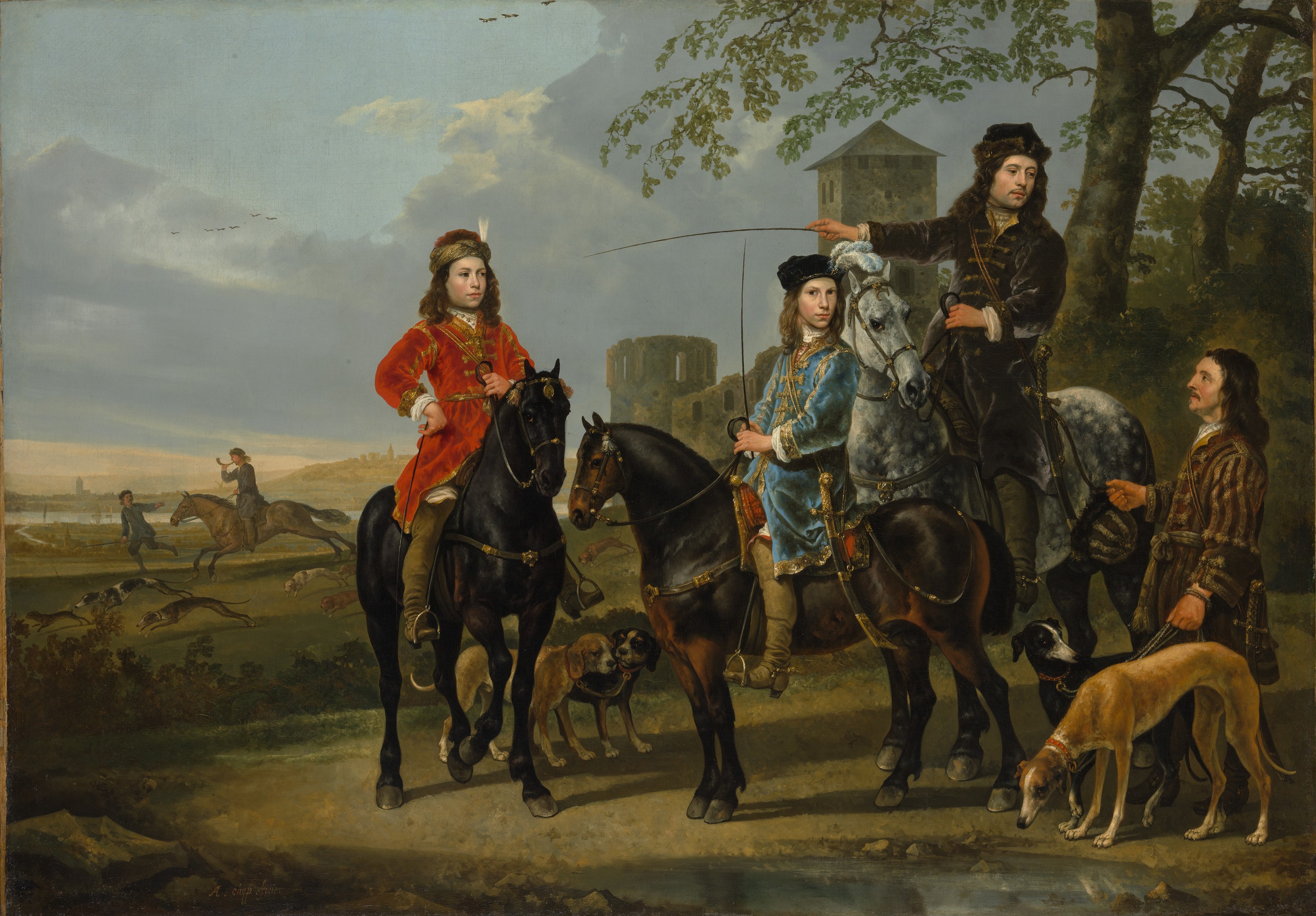
Aelbert Cuyp Dutch, Dordrecht 1620 – 1691 Dordrecht Equestrian Portrait of Cornelis (1639 – 1680) and Michiel Pompe van Meerdervoort (1638 – 1653) with Their Tutor and Coachman , ca. 1652 – 53 Oil on canvas The Friedsam Collection, Bequest of Michael Friedsam, 1931 (32.100.20)
This portrait of two adolescent scions of an eminent family was most likely commissioned by their widowed mother. Instead of depicting an actual country estate, Cuyp placed a ruined castle in the background, evoking the sitters’ ancient lineage. Sitting astride horses, accompanied by retainers and hounds, the two youths pose as propertied huntsmen, ready at any moment to depart for the conquest of their prey. Cuyp’s skill as a lands cape painter is in tension with the relative awkwardness of the figures.
Jan van der Heyden Dutch, Gorinchem 1637 – 1712 Amsterdam
Huisten Bosch at The Hague and Its Formal Garden (View from the South) , ca. 1668 – 70
Huisten Bosch at The Hague and Its Formal Garden (View from the East) , ca. 1668 – 70 Oil on wood Gift of Edith Neuman de Végvár, in honor of her husband, Charles Neuman de Végvár, 1964 (64.65.2, .3)
Both an artist and an inventor (among other urban improvements, he conceived the fire pump), Van der Heyden specialized in precise and luminous cityscapes and views of country houses. These two jewel - like paintings depict Huisten Bosch (House in the Woods), the country home of the widowed Princess of Orange and still a residence of the Dutch royal family today. Van der Heyden shows the house amid its formal garden of hedgerows, pavilions, and obelisks, peopled by laboring gardeners and strolling aristocrats. French - style gardens like this one expressed an ideal of nature brought entirely under hu man control, ordered and harmonious.
Jan Weenix Dutch, Amsterdam ca. 1641? – 1719 Amsterdam Gamepiece with a Dead Heron , 1695 Oil on canvas Rogers Fund, 1950 (50.55)
Likely destined for a townhouse, this decorative painting evokes the bounty of the hunt on a country estate. A heron and other dead birds spill out of a game bag next to a large neoclassical urn. The animal trophies figure as a natural feature of the courtly landscape, while the tumult of the hunt remains offstage. In the background, aristocratic figures stroll at the edge of an ornamental pond, complete with gliding swans.
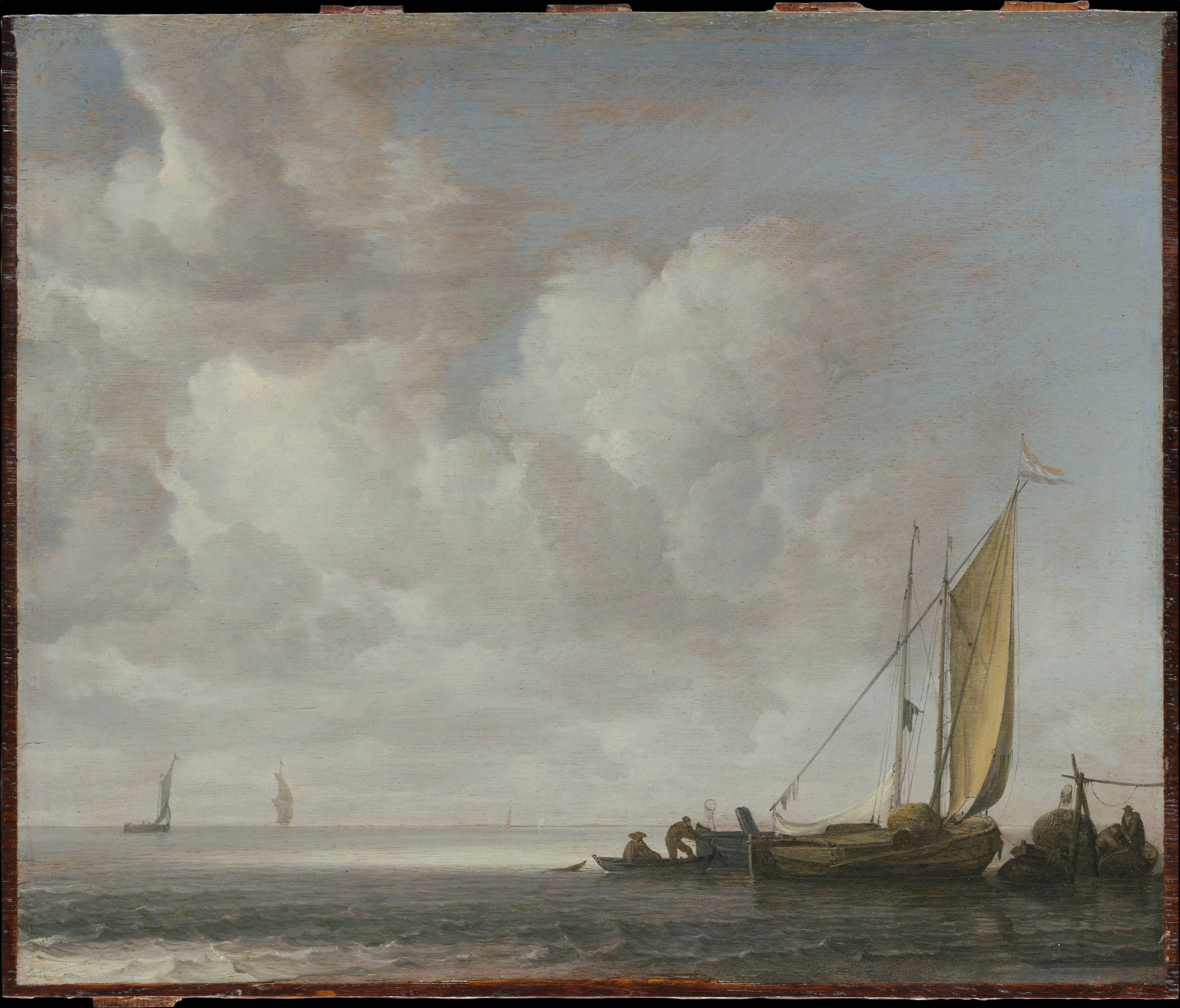
Simon de Vlieger Dutch, Rotterdam? ca. 1600/1601 – 1653 Weesp Calm Sea , after 1640 Oil on wood Rogers Fund, 1906 (06.1200)
On the left the horizon line dissolves into a vast becalmed sea, while fishermen ply their trade on the right. De Vlieger influenced later marine painters by working with a limited tonal range to achieve precisely calibrated effects of light in the sky and water. His observations of northern light established him as the master of a particularly local landscape, affirmed by the Dutch flag fluttering above the boat on the right.

Salomon van Ruysdael Dutch, Naarden, born ca. 1600 – 1603, died 1670 Haarlem Drawing the Eel , early 1650s Oil on wood Purchase, 1871 (71.75)
Against a wintry sky and bare branches, this village road becomes the setting for a cruel pastime: a live eel strung on a line is plucked down by young people charging past on horseback. The contest provides the pretext for a festive gathering, all owing Ruysdael to combine his eye for local color with an evocation of limpid winter light and its reflection in the frozen skating pond below.
Willem van de Velde II Dutch, Leiden 1633 – 1707 London Entrance to a Dutch Port , ca. 1665 Oil on canvas Bequest of William K. Vanderbilt, 1920 (20.155.6)
Van de Velde received his first training from his father, a celebrated draftsman of ships. This view of a port combines nautical accuracy with the tonal painting he learned from another teacher, Simon de Vlieger, whose work hangs nearby. The vessels depicted range from small cargo and fishing boats to a state barge and East Indiamen destined for long voyages of trade and imperialism. Two humble figures wade ashore, connecting the maritime panorama to the beholder ’ s space on solid ground.
Jan van Goyen Dutch, Leiden 1596 – 1656 The Hague Castle by a River , 1647 Oil on wood Gift of Edith Neuman de Végvár, in honor of her husband, Charles Neuman de Végvár, 1964 (64.65.1)
This scene of fishermen casting their net in front of a moated fortress catered to a taste for picturesque and ancient architecture. Working on the smooth surface of an oak panel allowed Van Goyen to achieve a variety of painterly effects and enliven a limited color palette as he evoked crumbling masonr y, rippling water, or cottony clouds. Although the artist studied medieval monuments in preparing such scenes, the castle shown here is imaginary, pieced together from both observation and fantasy.
Contested Bodies
[Rembrandt] chose no Greek Venus as his model / But rather a washerwoman or a treader of peat from a barn / And called this whim “ imitation of nature. ” — Andries Pels, 1681
History painting, depicting episodes from classical myth and the Bible, was the most prestigious ategory of art by seventeenth - century standards. It required artists to master the depiction of the human form, considered to be the basic building block of visual storytelling. Nonetheless, Dutch painters took divergent approaches to depicting the body. Some assimilated their figures to a classical ideal, based more on ancient sculpture than on close observation of live models. Others, most notoriously Rembrandt, populated their history paintings with ordinary - looking people who seemed to have stepped right off the street and into the artist’s studio.

Abraham Bloemaert Dutch, Gorinchem 1566 – 1651 Utrecht Moses Striking the Rock , 1596 Oil on canvas Purchase, Gift of Mary V. T. Eberstadt, by exchange, 1972 (1972.171)
Extended, contorted, and preternaturally muscled bodies are a hallmark of Bloemaert’s style, which art historians refer to as Mannerism. In the middle ground at left, nearly hidden in shadow, Moses strikes a rock to provide water for the Israelites during their flight from Egypt. But other figures such as the monumental bare - breasted woman with a water pitcher on her back overshadow the ostensible subject, revealing the painter’s priority to be the depiction of a variety of idealized bodies inspired by a dialogue with contemporary Italian art.

Paulus Bor Dutch, Amersfoort ca. 1601 – 1669 Amersfoort The Disillusioned Medea , ca. 1640 Oil on canvas Gift of Ben Heller, 1972 (1972.261)
In ancient myth, the sorceress Medea fell in love with the hero Jason and helped him to steal the fleece of a golden ram from her father. After having two sons with her, Jason abandoned Medea, driving her to murder their children as well as his new bride. Bor shows Medea before this dreadful act, slumped in melancholy. The artist devoted careful antiquarian attention to the backdrop of a pagan altar adorned with garlands, an ox skull, and a smoldering lamp, but his Medea resembles an ordinary young woman, prompting e mpathy and identification on the part of beholders.
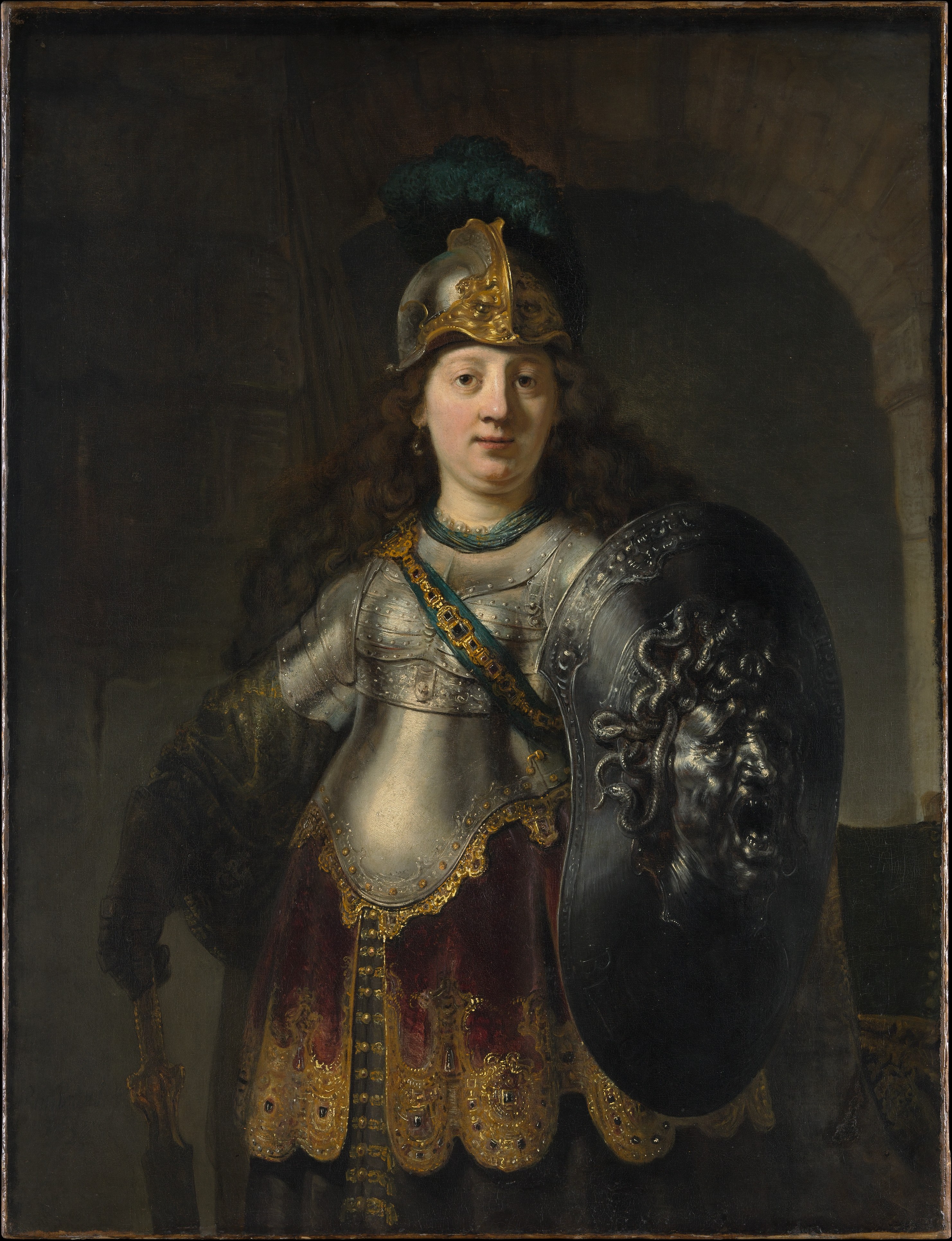
Rembrandt (Rembrandt van Rijn) Dutch, Leiden 1606 – 1669 Amsterdam Bellona , 1633 Oil on canvas The Friedsam Collection, Bequest of Michael Friedsam, 1931 (32.100.23)
Typical of Rembrandt’s domestication of ancient myth, this depiction of the Roman goddess of war may have reflected the Dutch readiness for conflict during the Eighty Years ’ War with Spain. In Praise of Painting Rather than reaching for an idealized source in ancient sculpture, Rembrandt based his depiction of the deity on a contemporary woman. The glittering surfaces of Bellona ’ s armor and fearsome shield allowed the young painter to give a bravura display of his skill.
Rembrandt (Rembrandt van Rijn) Dutch, Leiden 1606 – 1669 Amsterdam The Toilet of Bathsheba , 1643 Oil on wood Bequest of Benjamin Altman, 1913 (14.40.651)
Rembrandt shows the biblical figure Bathsheba completely nude, lost in a moment of contemplation and unaware that she is being observed by King David in the dist ant tower in the background. Classicist critics particularly objected to Rembrandt’s realistic representation of the female body, declaring that the marks of garters could be seen on the legs of his figures from history or myth — see Bathsheba’s left calf here. Like much of the picture, the attendant arranging Bathsheba’s hair is badly abraded from past cleaning, but she may have been intended to represent a woman of African origin. The diminutive scale indicates it was destined for a collector’s cabinet, meant to be pored over by a single viewer.
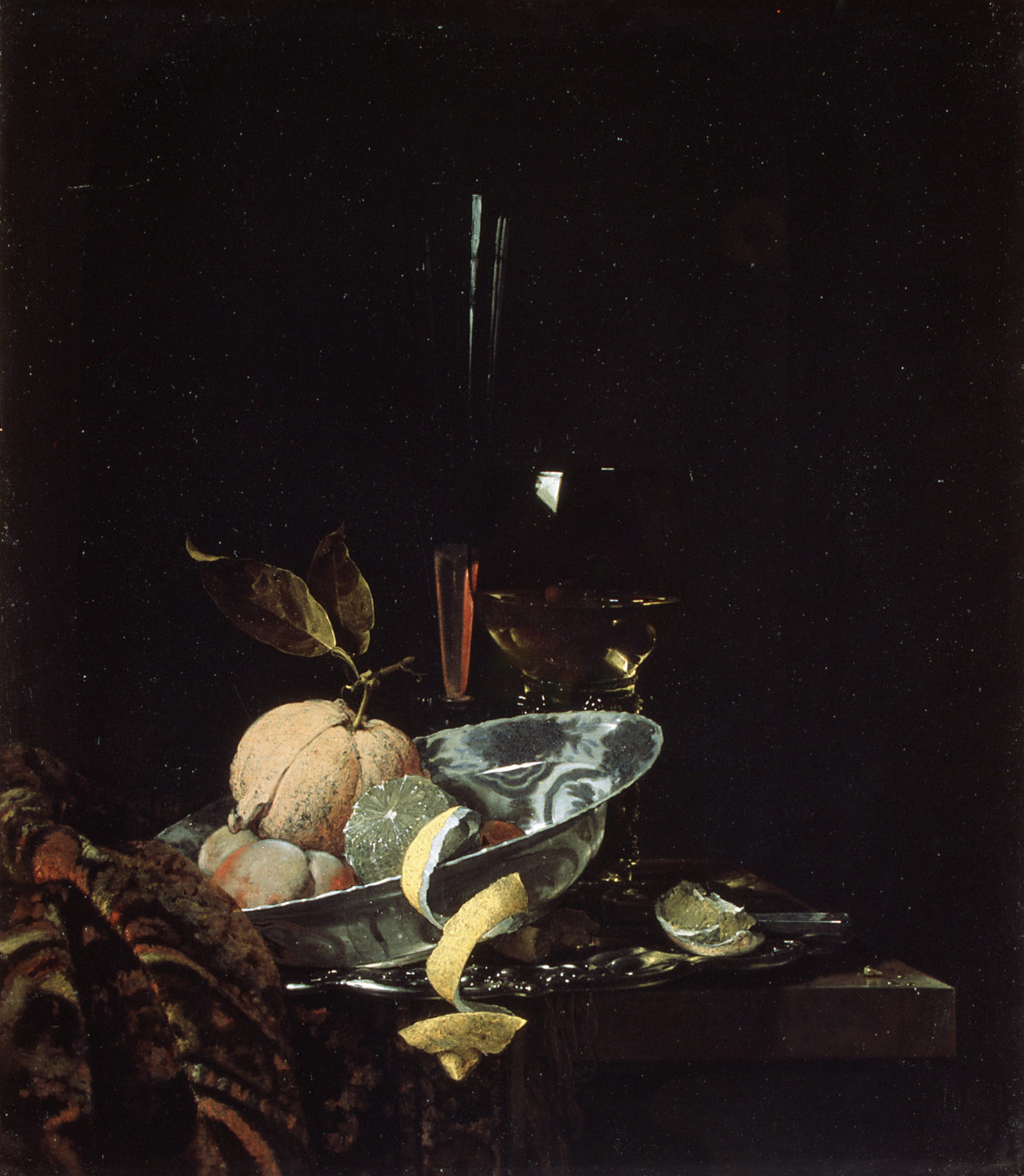
Willem Kalf Dutch, Rotterdam 1619 – 1693 Amsterdam Still Life with Fruit, Glassware, and a Wanli Bowl , 1659 Oil on canvas Maria DeWitt Jesup Fund, 1953 (53.111)
The Chinese porcelain bowl and Turkish carpet in this still life would both have been luxurious imports, here nonchalantly placed with wine and fruit on a wooden table. The bow l, a lemon peel spilling over its lip, balances on a piece of bread, animating the static arrangement of the objects. According to Gerard de Lairesse, a painter and writer of the next generation, Kalf “ surpassed others in still life, ” although “ he never . . . knew how to explain his images, why he depicted this or that, but simply [painted] whatever took his fancy. ”
Hendrick Sorgh Dutch, Rotterdam 1609/11 – 1670 Rotterdam A Kitchen , ca. 1643 Oil on wood Marquand Collection, Gift of Henry G. Marquand, 1889 (8 9.15.7)
In this painting, Sorgh inflects a domestic scene with the art of still life. Two maids clean fish and peel vegetables in the foreground, surrounded by gleaming brass and earthenware. A closer look reveals a mischievous cat, an open birdcage, and, barely visible between the two servants, a couple caressing in the shadows. Even such seemingly innocuous elements as the earthenware pots would have carried an erotic connotation for seventeenth - century viewers.

Abraham van Beyeren Dutch, The Hague 1620/21 – 1690 Overschie Still Life with Lobster and Fruit , probably early 1650s Oil on wood Gift of E dith Neuman de Végvár, in honor of her husband, Charles Neuman de Végvár, 1971 (1971.254)
Brilliant surfaces of metalwork and glass reflect lush fruits and a lobster in this still life. Heavily laden tables like this one, boasting both foodstuffs and impor ted luxuries such as the blue - and - white porcelain bowl from China, typify Dutch still life in the second half of the seventeenth century. Such paintings represent a shift away from the reminders of immortality and vanity in earlier still lifes and toward a wholehearted embrace of earthly pleasures.
Otto Marseus van Schrieck Dutch, Nijmegen 1619/20 – 1678 Amsterdam Still Life with Poppy, Insects, and Reptiles , ca. 1670 Oil on canvas Rogers Fund, 1953 (53.155)
Known to contemporaries as “ The Snuffler ” due to his apparent penchant for rooting around in the undergrowth, Marseus van Schrieck had close ties with the seventeenth - century culture of scientific investigation. This picture of the forest floor bristles with interactions between a lizard, snake, snails, and butterflies, all in the shadow of a poppy. Rather than painting flowers elegantly arranged in a vase, Marseus locates his blooms in a natural setting touched with an element of menace.
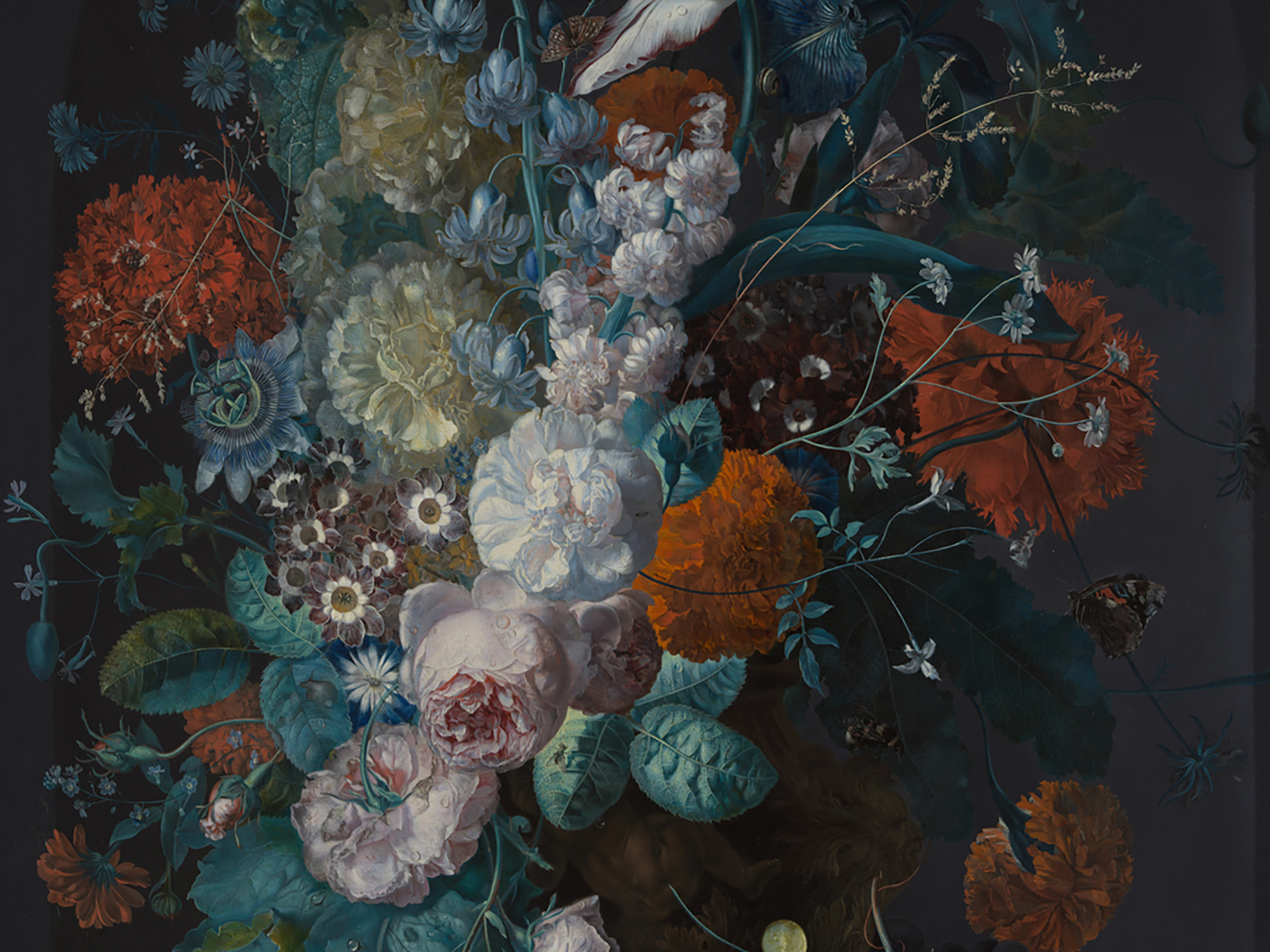
Margareta Haverman Dutch, active 1716 – 22 A Vase of Flowers , 1716 Oil on wood Purchase, 1871 (71.6)
Because hardly any women artists had access to nude models, a number of them became still life specialists. Haverman studied with the notoriously secretive flower painter Jan van Huysum and later g ained admission to the Royal Academy in Paris, from which she was soon expelled for unknown reasons. The artist’s skill is on full display in this magnificent arrangement of flowers and fruit, in which she used innovative pigments such as Prussian blue. Over time, the organic yellow lake pigment has faded, resulting in the present blue appearance of the leaves. Acquired in 1871, this is the sole painting in the collection by an early modern Dutch woman.
Johannes Vermeer Dutch, Delft 1632 – 1675 Delft Study of a Young Woman , ca. 1665 – 67 Oil on canvas Gift of Mr. and Mrs. Charles Wrightsman, in memory of Theodore Rousseau Jr., 1979 (1979.396.1)
Soft light illuminates the face of a young woman dressed in exotic clothing and costume jewelry. Like Vermeer ’s famous Girl with a Pearl Earring (ca. 1665; Mauritshuis, The Hague), this painting was most likely not a commissioned portrait, but rather a so - called tronie , a portrayal of an intriguing individual, often in fanciful costume.
Johannes Vermeer Dutch, Delft 1632 – 1675 Delft Young Woman with a Water Pitcher , ca. 1662 Oil on canvas Marquand Collection, Gift of Henry G. Marquand, 1889 (89.15.21)
Standing at an open window, a woman begins her day with ablutions from a gilt - silver pitcher and basin, with linen coverings protecting her dress and hair. The first work by Vermeer to enter an American collection, this painting embodies the artist ’ s inter est in domestic themes, giving an almost voyeuristic glimpse into the private life of a woman before she presents her public face to the world.
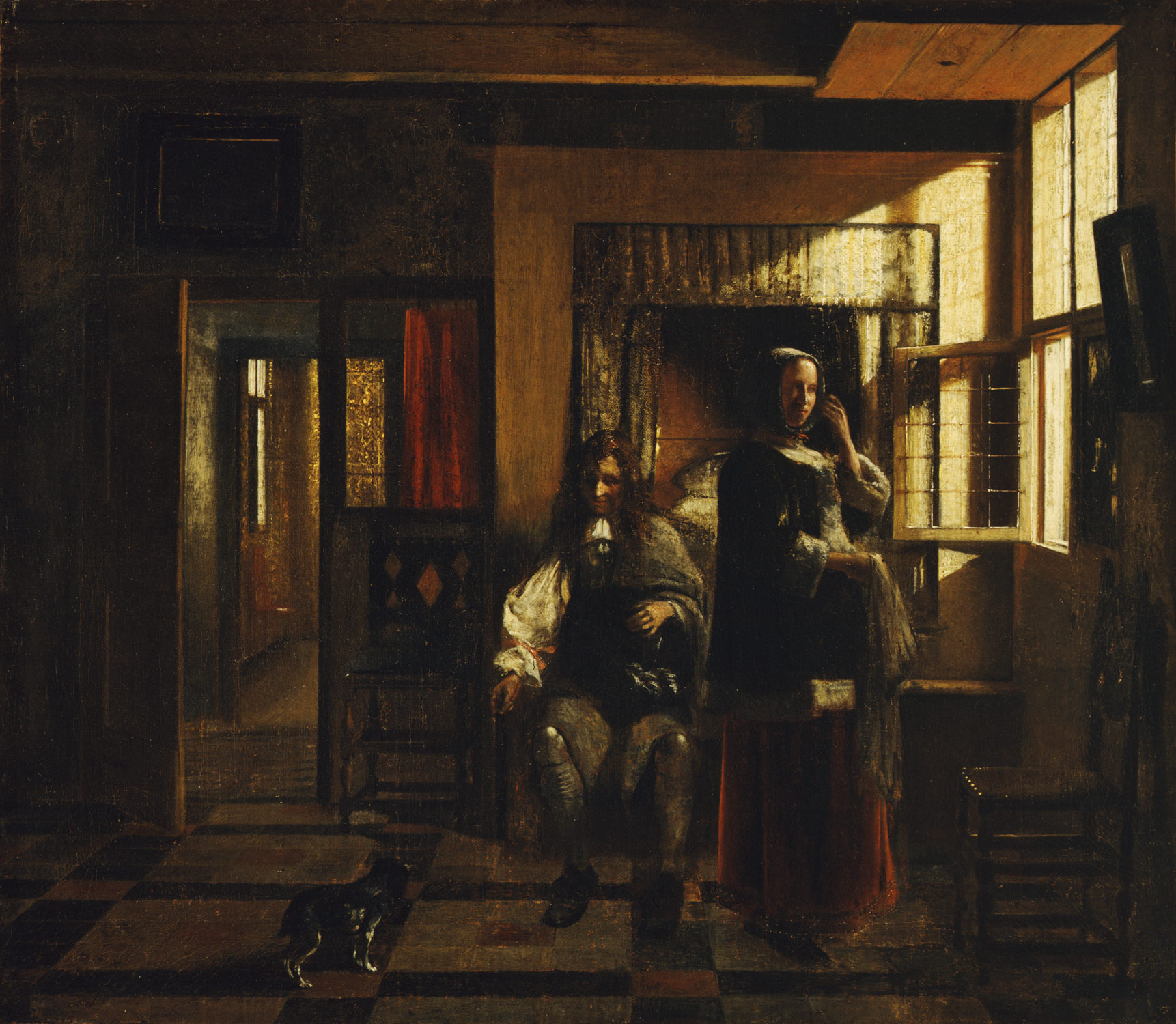
Pieter de Hooch Dutch, Rotterdam 1629 – 1684 Amsterdam Interior with a Young Couple , probably ca. 1662 – 65 Oil on canvas Bequest of Benjamin Altman, 1913 (14.40.613)
De Hooch was particularly skilled at interior scenes that capture the fall of light into rooms constructed from elaborately interlocking rectangular forms. These spaces provide the back drop for a glimpse into the private lives of prosperous families. Here we see a young couple sharing an intimate moment in their bedroom; the woman gazes into a mirror on the wall, while the man plays with their dog.
Pieter de Hooch Dutch, Rotterdam 1629 – 1684 Amsterdam The Visit , ca. 1657 Oil on wood H. O. Havemeyer Collection, Bequest of Mrs. H. O. Havemeyer, 1929 (29.100.7)
De Hooch situated this scene in a voorhuis , the street - facing room in a narrow Dutch row house that received the best light. The pla cement of the window and construction of the space reveal the close dialogue that De Hooch had with Vermeer at the time. But elements such as the plate of aphrodisiac oysters and canopied bed suggest that De Hooch most likely intended this particular scene to represent a brothel rather than a respectable home.
Pieter de Hooch Dutch, Rotterdam 1629 – 1684 Amsterdam Leisure Time in an Elegant Setting , ca. 1663 – 65 Oil on canvas Robert Lehman Collection, 1975 (1975.1.144)
De Hooch depicts a family in a luxurious interior with gilt - leather wallpaper, Chinese porcelain, and a suggestive painting of naked lovers above the cabinet. But the family ’ s ease and prosperity exist in tension with another scene, glimpsed through the open door on the far right. There, a young man confronts a bearded figure on the threshold, perhaps a wayfarer seeking alms.
Johannes Vermeer ( Dutch, Delft 1632 – 1675 Delft ). Young Woman with a Water Pitcher , ca. 1662 . Oil on canvas , 18 x 16 in. (45.7 x 40.6 cm) . The Metropolitan Museum of Art, New York, Marquand Collection, Gift of Henry G. Marquand, 1889 ( 89.15.21 )
Abraham van Beyeren ( Dutch, The Hague 1620/21 – 1690 Overschie ). Still Life with Lobster and Fruit , probably early 1650s . Oil on wood , 38 x 31 in. (96.5 x 78.7 cm) . The Metropolitan Museum of Art, New York, Gift of Edith Neuman de Végvár, in honor of her husband, Charles Neuman de Végvár, 1971 ( 1971.254 )
Gerard ter Borch the Younger ( Dutch, Zwolle 1617 – 1681 Deventer ). A Woman Playing the Theorbo - Lute and a Cavalier , ca. 1658 . Oil on wood . 14 1/2 x 12 3/4 in. (36 .8 x 32.4 cm) . The Metropolitan Museum of Art, New York, Bequest of Benjamin Altman, 1913 ( 14.40.617 )
Pieter Claesz (Dutch, Berchem? 1596/97 – 1660 Haarlem ). Still Life with a Skull and a Writing Quill , 1628 . Oil on wood . 9 1/2 x 14 1/8 in. (24.1 x 35.9 cm) . The Metropolitan Museum of Art, New York, Rogers Fund, 1949 ( 49.107 )
Aelbert Cuyp ( Dutch, Dordrecht 1620 – 1691 Dordrecht ). Young Herdsmen with Cows , ca. 1655 – 60 . Oil on canvas . 44 1/8 x 52 1/8 in. (112.1 x 132.4 cm) . The Metropolitan Museum of Art, New York, Bequest of Benjamin Altman, 1913 ( 14.40.616 )
Gerrit Dou ( Dutch, Leiden 1613 – 1675 Leiden ). Self - Portrait , ca. 1665 . O il on wood , 19 1/4 x 15 3/8 in. (48.9 x 39.1 cm) . The Metropolitan Museum of Art, New York, Bequest of Benjamin Altman, 1913 ( 14.40.607 ) I
Frans Hals ( Dutch, Antwerp 1582/83 – 1666 Haarlem ) Young Man and Woman in an Inn ("Yonker Ramp and His Sweetheart") , 1623 . Oil on canvas . 41 1/2 x 31 1/4 in. (105.4 x 79.4 cm) . The Metropolitan Museum of Art, New York, Bequest of Benjamin Altman, 1913 ( 14.40.602 )
Frans Hals ( Dutch, Antwerp 1582/83 – 1666 Haarlem ). Merrymakers at Shrovetide , ca. 1616 – 17 . Oil on canvas . 51 3/4 x 39 1/4 in. (131.4 x 99.7 cm) . The Metropolitan Museum of Art, New York, Bequest of Benjamin Altman, 1913 (14.40.605)
Margareta Haverman ( Dutch, active by 1716 – died 1722 or later ). A Vase of Flowers , 1716 . Oil on wood , 31 1/4 x 23 3/4 in. (79.4 x 60.3 cm) . The Metropolitan Museum of Art, New York, Purchase, 1871 ( 71.6 )
Meyndert Hobbema ( Dutch, Amsterdam 1638 – 1709 Amsterdam ). Woodland Road , ca. 1670 . Oil on canvas . 37 1/4 x 51 in. (94.6 x 129.5 cm) . The Metropolitan Museum of Art, New York, Bequest of Mary Stillman Harkness, 1950 ( 50.145.22 ) I
Nicolaes Maes ( Dutch, Dordrecht 1634 – 1693 Amsterdam ). Young Woman Peeling Apples , ca. 1655 . Oil on wood . 21 1/2 x 18 in. (54.6 x 45.7 cm) . The Metropolitan Museum of Art, New York, Bequest of Benjamin Altman, 1913 ( 14.40.612 )
Rembrandt (Rembrandt van Rijn) ( Dutch, Leiden 1606 – 1669 Amsterdam ). Self - Portrait , 1660 . Oil on canvas . 31 5/8 x 26 1/2 in. (80.3 x 67.3 cm) . The Metropolitan Museum of Art, New York, Bequest of Benjamin Altman, 1913 ( 14.40.61 8 )
Rembrandt (Rembrandt van Rijn) ( Dutch, Leiden 1606 – 1669 Amsterdam ). Woman with a Pink , early 1660s . Oil on canvas . 36 1/4 x 29 3/8 in. (92.1 x 74.6 cm) . The Metropolitan Museum of Art, New York, Bequest of Benjamin Altman, 1913 ( 14.40.622 )
Jacob van Ruisdael ( Dutch, Haarlem 1628/29 – 1682 Amsterdam ). Wheat Fields , ca. 1670 . Oil on canvas , 39 3/8 x 51 1/4 in. (100 x 130.2 cm) . The Metropolitan Museum of Art, New York, Bequest of Benjamin Altman, 1913 ( 14.40.623 )
Jan Steen ( Dutch, Leiden 1626 – 1679 Leiden ). The Dissolute Household , ca. 1663 – 64 . Oil on canvas , 42 1/2 x 35 1/2 in. (108 x 90.2 cm) . The Metropolitan Museum of Art, New York, The Jack and Belle Linsky Collection, 1982 ( 1982.60.31 )
Johannes Vermeer ( Dutch, Delft 1632 – 1675 Del ft A Maid Asleep , ca. 1656 – 57 . Oil on canvas . 34 1/2 x 30 1/8 in. (87.6 x 76.5 cm) . The Metropolitan Museum of Art, New York, Bequest of Benjamin Altman, 1913 ( 14.40.611 )
Johannes Vermeer ( Dutch, Delft 1632 – 1675 Delft ). Study of a Young Woman , ca. 1665 – 67 . O il on canvas . 17 1/2 x 15 3/4 in. (44.5 x 40 cm) . The Metropolitan Museum of Art, New York, Gift of Mr. and Mrs. Charles Wrightsman, in memory of Theodore Rousseau Jr., 1979 ( 1979.396.1 )
Emanuel de Witte ( Dutch, Alkmaar ca. 1616 – 1692 Amsterdam ). Interior of the Oude Kerk, Delft , probably 1650 . Oil on wood . 19 x 13 5/8 in. (48. 3 x 34.6 cm) . The Metropolitan Museum of Art, New York, Purchase, Lila Acheson Wallace, Virgilia and Walter C. Klein, The Walter C. Klein Foundation, Edwin Weisl Jr., and Frank E. Richardson Gifts, and Bequest of Theodore Rousseau and Gift of Lincoln Kirstein, by exchange, 2001 ( 2001.403 )
Peter Wtewael ( Dutch, Utrecht 1596 – 1660 Utrecht ). Kitchen Scene , 1620s . Oil on canvas . 44 3/4 x 63 in. (113.7 x 160 cm) . The Metropolitan Museum of Art, New York, Rogers Fund, 1906 ( 06.288 )